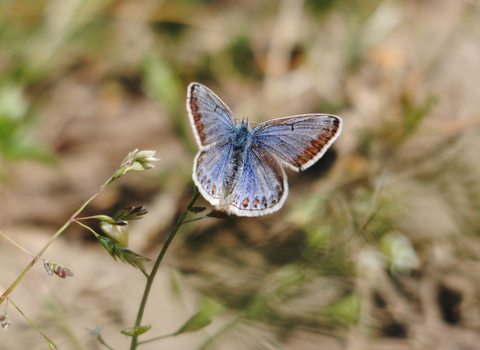Male Common Blue ©Zsuzsanna Bird

Common Blue ©Ross Hoddinott/2020VISION

Female Common Blue ©Amy Lewis
Common blue
The common blue butterfly lives up to its name - it's bright blue and found in all kinds of sunny, grassy habitats throughout the UK! Look out for it in your garden, too.
Scientific name
Polyommatus icarusWhen to see
May to OctoberSpecies information
Statistics
Wingspan: 2.9-3.6cmCommon.
About
The common blue is a small blue butterfly that flies throughout the summer between April and October. The most widespread of the blue butterflies, it is found in a variety of habitats, including heathland, woodland rides, grassy meadows, parks, large gardens and waste ground. Caterpillars feed on clovers, restharrow, common bird's-foot trefoil and related plants.How to identify
The male common blue has bright blue wings with a brown border and white fringe. The female is brown with a blue 'dusting' near the body. It has orange spots on the underside of its hindwings, whereas the similar holly blue has black spots. It is larger than the small and silver-studded blues, smaller than the rare large blue, brighter than the chalkhill blue, and lacks the black- and white-chequered pattern along the edge of the wings of the adonis blue.Distribution
Widespread, but absent from the Shetland Islands.Did you know?
There are typically two generations of common blues in a year, but if the weather is warm, there can be up to three broods over the spring and summer.Watch
Common blue butterfly on bird's-foot trefoil (https://vimeo.com/427733006)
Common blue butterfly on bird's-foot trefoil ©Tom Hibbert
